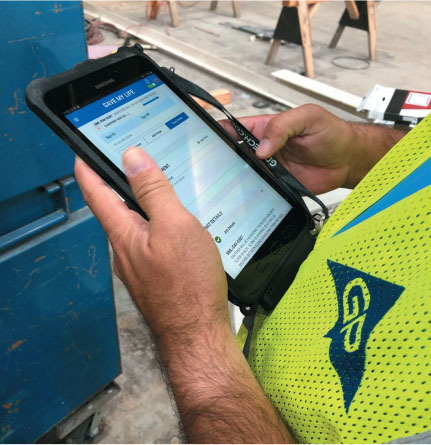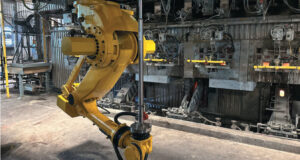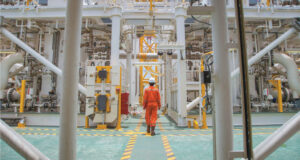“Safety touches everything and everyone should be empowered to improve it.” Those words come from Chad Harrod, director of process safety projects at Georgia-Pacific, an Atlanta-based manufacturer with
 more than 150 locations around the world. GP makes cellulose pulp, consumer products for home and AFH, wood and gypsum building products, and a variety of packaging. Its brands include household names like Dixie, Brawny, and Quilted Northern. With more than 30,000 employees to care for, it’s no wonder that “safety” pops up in every news story you’ll read about this industry leader.
more than 150 locations around the world. GP makes cellulose pulp, consumer products for home and AFH, wood and gypsum building products, and a variety of packaging. Its brands include household names like Dixie, Brawny, and Quilted Northern. With more than 30,000 employees to care for, it’s no wonder that “safety” pops up in every news story you’ll read about this industry leader.
For this article, we look first at GP’s Save My Life Digital Work Process, which uses technology to put the best information in front of employees when they need it. We also hear from GP team members passionate about digester safety and check in on a CapEx project at GP’s Muskogee mill. Finally, we’ll share a few resources to help readers interested in following GP’s “safety everywhere” example.
The Life You Save…
The Save My Life process represents a transformation of traditional permit-to-work processes, transforming the traditional model from “stop, think, and ask” to “start when certain,” ensuring that both prevention and recovery controls are in place before beginning high-risk work. To develop the program, the company assembled a team of frontline personnel, safety and health leaders, IT leaders, and project managers to think through the transformation. Less than two years later, the Save My Life (SML) thought process and mobile application is GP’s new permitting standard. SML is an important tool in reducing the risk of the most serious injuries and is part of GP’s aspirational goal of zero significant injuries.
The successful launch and implementation of SML across Georgia-Pacific sites gave safety and health managers Chuck Watts and Chris Brown the confidence they needed to share their knowledge outside the company. They traveled the US to share Georgia-Pacific’s experience with safety professionals across many industries.

“Innovative systems like Save My Life are critical to managing complex environments and providing information to employees to help them learn new ways of doing new and sometimes hazardous work while staying safe,” says Watts. “We believe that the process has started to accelerate our transformation of how we view and execute hazardous work in our facilities across the organization.”
Dawn Wurst, GP’s senior VP, safety and health, shared more at the 2023 Pulp and Paper Safety Association (PPSA) Conference (see sidebar to learn more about PPSA). The process began, she said, with three simple questions:
- “How could we increase the value of the work permitting process by front-end loading the safety discussions?”
- “How can we focus on the critical few controls that are vital?”
- “We’ve introduced Human and Organizational Performance (HOP) tools—now how do we walk that talk?”
The idea behind SML was to give individuals the ability to “fail safely” by assessing all work activities (before, during, and after each task) to prevent death and serious injury. To do this, the company concentrated on work that involves the most risk to human life; this includes energy control, hot work, working from height, confined space entry, lifting and rigging, line break, and more. The GP team used Google’s Sprint Process to create and prototype a completely new process within a week, then spent a year moving from a minimum viable product to a field-used product designed by permit users.
At the core was this critical thought process: “When this fails, what will kill me or change my life? What controls are in place? Is that enough?”
The SML program allows users to apply the HOP process through the tool and, while Wi-Fi does help “sync” permits on other devices and on the App Manager for real-time viewing, it is not needed to permit. The company says that SML has already resulted in more than 1,800 “catches” where additional controls were applied before starting work.
It was a complex process with many learnings along the way, yet Wurst told PPSA Conference attendees that GP had a few clear “wins:”
- They pursued leader buy-in first;
- asked front line workers to state what they needed, and asked them to help design it;
- set clear criteria for the minimum viable product; and
- developed a strong implementation plan that started with a few sites and slowly grew.
GP’s efforts to share the success of SML have paid off: the American Forest and Paper Association (AF&PA) awarded the company its 2023 Leadership in Sustainability Award for the Save My Life Digital Work Process.
“Saving lives doesn’t stop with our employees or the contractors that come on our sites. Saving lives is bigger than Georgia-Pacific,” says Brown. “We believe the SML thought process is a much better approach. If we believe we can find success in saving lives with SML, we felt we needed to share that.”
Learning and Teaching about Digester Safety
Every pulp manufacturer understands the risk of a catastrophic digester failure. Far worse than the loss of equipment or production time, these explosions have caused severe injury and even death. A panel session addressing Digester Safety was met with great enthusiasm by attendees at the 2023 TAPPI PEERS Conference (see sidebar to learn more about PEERS.) Presenters included Chad Harrod, director of process safety projects and Engineer Kyle Lindsay, both with Georgia-Pacific. We asked them to share their perspectives on this critical topic and why it matters to GP.
Paper360°: Why is Digester Safety so important for our industry?
HARROD: I believe that every individual in our industry has a fiduciary responsibility to support safe manufacturing—no matter if you work at a manufacturing site in operations or maintenance, at a supplier providing new technology or equipment, at an engineering firm designing integration of the balance of plant components, a sales manager of pulp/paper products giving a tour of a mill, or wherever. Safety applies to all companies, all disciplines, all roles, from CEO to the operator rodding smelt spouts. Equipment should never catastrophically fail and jeopardize the safety of anyone. Past digester failures are a wake-up call to the pulp and paper industry that we must do better.
I was quite surprised to find that no active digester safety forum existed in the pulp and paper industry—like the BLRBAC forum exists for recovery boiler safety. TAPPI has several relevant Technical Information Papers (TIPs) and used to have a Digester Corrosion Committee, but that ended around 2005. At the 2022 TAPPI PEERS conference, I led a “Hot Topic Breakfast” and Plant Engineering and Corrosion committee discussion on Digester Safety. A group of 10 volunteers agreed to participate in a Digester Safety Work Group chaired by Matthew Tunnicliffe from FPInnovations. We held quarterly knowledge shares on Microsoft Teams that were a huge success—one had more than 100 participants! It is great to see industry owners, equipment suppliers, engineering firms, and insurance representatives collectively come together to improve digester safety.
What do you hope were the chief “take-aways” for attendees of your 2023 PEERS session?
LINDSAY: The biggest challenge in our industry is knowledge retention—the days of “knowing what to look for” are long gone due to retirements and employee retention. The research I conducted for my paper on Corrosion Under Insulation (CUI) on Continuous Digester Vessels showed that this is not a new topic, but its importance has not passed down to today’s engineers.
My paper shared two recent experiences at GP with this issue. The main “take-aways” are that other external mechanisms of corrosion are occurring—but this external corrosion has been overlooked because most of the focus has been on Stress Corrosion Cracking (SCC) of internal digester weld seams. The examples I presented did not result in catastrophic loss or injury, but they could have if not discovered and repaired.
HARROD: My paper shared GP experiences with Continuous Digester Caustic SCC and Over-Pressure Protection systems. My main takeaway for attendees is that an aging digester fleet (both batch and continuous) needs more attention regarding inspection, repair, and replacement. Mechanical integrity depends on both vessel strength and over pressure protection. TAPPI and others have done a significant amount of work in the past regarding digester corrosion, but there are opportunities for improvement.
What do you feel has been the most critical recent advancement in digester safety?
LINDSAY: I believe the most critical recent advancement in digester safety is the creation of the Digester Safety Work Group that Chad mentioned. This work group has created a forum where various organizations can openly share issues and findings relevant to digester safety and collaborate to review, create, and improve TAPPI TIPs, inspection requirements, interlocks, and over-pressurization requirements. One of GP’s Principle Based Management (PBM) concepts is to strive for virtuous cycles of mutual benefit—this safety work group achieves that by creating a forum where we can collaborate and learn from each other with the overall goal of improving the safety of continuous digesters.
What sets apart the safety culture at Georgia-Pacific?
HARROD: We believe organizations have a culture, but not a specific safety culture. Doing things safely needs to be part of the overall culture. Our culture at Georgia-Pacific is founded on the PBM framework, based on principles of human progress that enable individuals and organizations to succeed long-term by creating superior value for others. PBM values “principles” over “rules,” and human judgment over strict protocols. Our safety vision outlines what we believe, what we will do, and what we won’t do, aligned with our company culture. Our vision sets expectations to avoid common pitfalls—such as assuming the worker is the problem when safety events occur, or waiting for an accident to learn how to improve.
LINDSAY: We promote a learning organization that is constantly reviewing hazards, events, and looking both internally and externally for the best knowledge to take advantage of concepts that move us forward in a way consistent with our PBM culture. The safety and well-being of our employees and communities is our first priority, always. We make this happen every day by building capability in our people and resilience in our systems to adapt, prevent, contain, and recover, so when the unexpected happens no one is exposed to a life threatening or altering event.
Investing in Safety
At GP’s mill in Muskogee, OK, big changes are elevating safety, quality, and reliability.
The facility is executing several projects worth US$50 million that are transforming its operations. The mill makes bath tissue, paper towels, and napkins for both retail and away-from-home markets, including well-known consumer brands such as Sparkle®.
Since the project was initially announce in May, 2022, some improvements have already been completed. Crews have installed a jumbo roll tissue line and implemented Automated Guided Vehicles (AGVs) in certain areas of the facility. AGVs use optimized, pre-programmed pathing, so they can move and place goods with greater efficiency and precision than human-operated vehicles. According to the manufacturer, “AGVs integrate with conveyors and other technology for a smooth transition between storage and handling.”
A new paper machine winder will soon replace the old one at the Muskogee facility. The final phase of the project will involve further automation where AGVs will be deployed to handle raw materials, streamline processes, and further enhance efficiency.
“This capital investment strengthens our commitment as a community partner and bolsters economic stability,” says Amy Borovich, Muskogee Mill facility leader. “Since the projects began, we’ve not only created new jobs but have also greatly improved the safety of our employees and reliability of our equipment that will meet the needs of our customers for many years to come.”
The mill has been in operation in Muskogee since 1978 and now employs more than 700 workers, making it the city’s largest private employer. “We are pleased Georgia-Pacific is investing in their facility and deepening their roots in Muskogee,” says Muskogee Mayor Marlon Coleman. “Their decision to grow here is a testament to our region’s skilled workforce and business-friendly environment.”
 Paper 360
Paper 360

